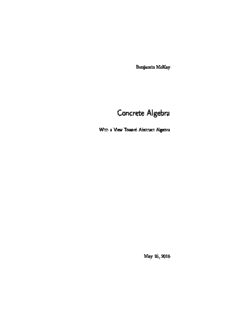Table Of ContentBenjamin McKay
Concrete Algebra
With a View Toward Abstract Algebra
May 16, 2016
ThisworkislicensedunderaCreativeCommonsAttribution-ShareAlike3.0UnportedLicense.
iii
Preface
WithmyfullphilosophicalrucksackIcanonlyclimbslowlyupthemoun-
tain of mathematics.
(cid:22) Ludwig Wittgenstein
Culture and Value
These notes are from lectures given in 2015 at University College Cork. They aim
to explain the most concrete and fundamental aspects of algebra, in particular the
algebra of the integers and of polynomial functions of a single variable, grounded
by proofs using mathematical induction. It is impossible to learn mathematics by
reading a book like you would read a novel; you have to work through exercises and
calculate out examples. You should try all of the problems. More importantly, since
the purpose of this class is to give you a deeper feeling for elementary mathematics,
rather than rushing into advanced mathematics, you should re(cid:29)ect about how the
following simple ideas reshape your vision of algebra. Consider how you can use
your new perspective on elementary mathematics to help you some day guide other
students, especially children, with surer footing than the teachers who guided you.
v
vi
The temperature of Heaven can be rather accurately computed.
Our authority is Isaiah 30:26, (cid:16)Moreover, the light of the Moon
shall be as the light of the Sun and the light of the Sun shall
be sevenfold, as the light of seven days.(cid:17) Thus Heaven receives
from the Moon as much radiation as we do from the Sun, and in
addition 7(cid:2)7 = 49 times as much as the Earth does from the
Sun, or 50 times in all. The light we receive from the Moon is
one1/10000ofthelightwereceivefromtheSun,sowecanignore
that.... The radiation falling on Heaven will heat it to the point
wheretheheatlostbyradiationisjustequaltotheheatreceivedby
radiation,i.e.,Heavenloses50timesasmuchheatastheEarthby
radiation. Using the Stefan-Boltzmann law for radiation, (H/E)
temperature of the earth ((cid:24) 300K), gives H as 798K (525(cid:14)C).
The exact temperature of Hell cannot be computed.... [However]
Revelations 21:8 says (cid:16)But the fearful, and unbelieving ...shall
havetheirpartinthelakewhichburnethwithfireandbrimstone.(cid:17)
Alakeofmolten brimstonemeansthatitstemperaturemustbeat
or below the boiling point, 444.6(cid:14)C. We have, then, that Heaven,
at 525(cid:14)C is hotter than Hell at 445(cid:14)C.
(cid:22) Applied Optics , vol. 11, A14, 1972
Inthesedaystheangeloftopologyandthedevilofabstractalgebra
fight for the soul of every individual discipline of mathematics.
(cid:22) Hermann Weyl
Invariants,DukeMathematicalJournal5,1939,489(cid:21)
502
(cid:22) and so who are you, after all?
(cid:22)Iampartofthepowerwhichforeverwillsevilandforeverworks
good.
(cid:22) Goethe
Faust
This Book is not to be doubted.
(cid:22) Quran , 2:1/2:6-2:10 The Cow
Contents
1 The integers 1
2 Mathematical induction 9
3 Greatest common divisors 15
4 Prime numbers 21
5 Modular arithmetic 25
6 Secret messages 39
7 Rational, real and complex numbers 45
8 Polynomials 53
9 Factoring polynomials 59
10 Resultants and discriminants 69
11 Permuting roots 79
12 Fields 91
13 Rings 101
14 Algebraic curves in the plane 107
15 Quotient rings 121
16 Field extensions and algebraic curves 127
17 The projective plane 129
18 Algebraic curves in the projective plane 135
19 Families of plane curves 147
20 The tangent line 155
21 Projective duality 165
22 Polynomial equations have solutions 167
23 More projective planes 171
Bibliography 189
List of notation 191
Index 193
vii
Chapter 1
The integers
God made the integers; all else is the work of man.
(cid:22) Leopold Kronecker
Notation
We will write numbers using notation like 1234567.12345, using a decimal point . at
the last integer digit, and using thin spaces to separate out every 3 digits before or
afterthedecimalpoint. Youmightprefer1,234,567(cid:1)123,45or1,234,567.123,45,which
arealsofine. Wereservethe(cid:1)symbolformultiplication, writing2(cid:1)3=6ratherthan
2(cid:2)3=6.
The laws of integer arithmetic
The integers are the numbers ...,−2,−1,0,1,2,.... Let us distill their essential
properties, using only the concepts of addition and multiplication.
Addition laws:
a. The associative law: For any integers a,b,c: (a+b)+c=a+(b+c).
b. Theidentitylaw:Thereisaninteger0sothatforanyintegera,a+0=a.
c. Theexistenceofnegatives:foranyintegera,thereisanintegerb(denote
by the symbol −a) so that a+b=0.
d. The commutative law: For any integers a,b, a+b=b+a.
Multiplication laws:
a. The associative law: For any integers a,b,c: (ab)c=a(bc).
b. The identity law: There is an integer 1 so that for any integer a, a1=a.
c. The zero divisors law: For any integers a,b, if ab=0 then a=0 or b=0.
d. The commutative law: For any integers a,b, ab=ba.
The distributive law:
a. For any integers a,b,c: a(b+c)=ab+ac.
1
2 The integers
Sign laws:
Anintegeraispositiveifitliesamongtheintegers1,1+1,1+1+1,...,negative
if −a is positive. Of course, we write 1+1 as 2, and 1+1+1 as 3 and so on.
We write a < b to mean that there is a positive number c so that b = a+c,
write a>b to mean b<a, write a(cid:20)b to mean a<b or a=b, and so on. We
writejajtomeana,ifa≥0,andtomean−aotherwise,andcallittheabsolute
value of a.
a. The inequality cancellation law for addition: For any integers a,b,c, if
a+c<b+c then a<b.
b. The inequality cancellation law for multiplication: If a < b and if c > 0
then ac<bc.
c. Determinacy of sign: Every integer a has precisely one of the following
properties: a>0, a<0, a=0.
The law of well ordering:
a. Any collection of positive integers has a least element; that is to say, an
element a so that every element b satisfies a(cid:20)b.
All of the other arithmetic laws we are familiar with can be derived from these. For
example,theassociativelawforaddition,appliedtwice,showsthat(a+b)+(c+d)=
a+(b+(c+d)), and so on, so that we can add up any finite sequence of integers, in
any order, and get the same result, which we write in this case as a+b+c+d. A
similar story holds for multiplication.
To understand mathematics, you have to solve a large number of problems.
I prayed for twenty years but received no answer until I prayed with my
legs.
(cid:22) Frederick Douglass, statesman and escaped slave
1.1 For each equation below, what law above justifies it?
a. 7(3+1)=7(cid:1)3+7(cid:1)1
b. 4(9(cid:1)2)=(4(cid:1)9)2
c. 2(cid:1)3=3(cid:1)2
1.2 Usethelawsabovetoprovethatifa,b,careanyintegersthen(a+b)c=ac+bc.
1.3 Use the laws above to prove that 0+0=0.
1.4 Use the laws above to prove that 0(cid:1)0=0.
1.5 Use the laws above to prove that, for any integer a, a(cid:1)0=0.
1.6 Use the laws above to prove that (−1)(−1)=1.
1.7 Use the laws above to prove that the product of any two negative numbers is
positive.

